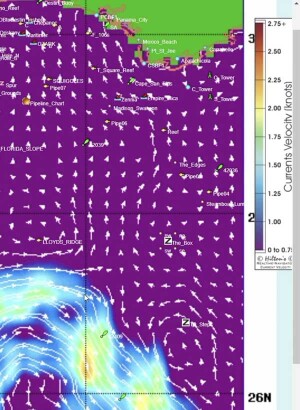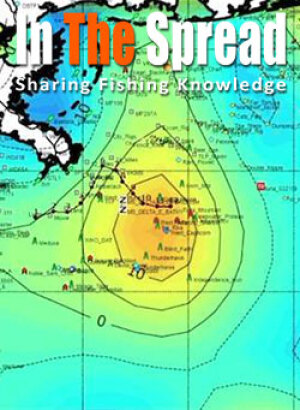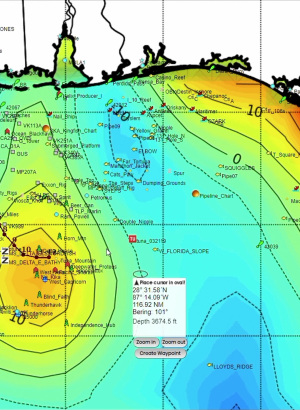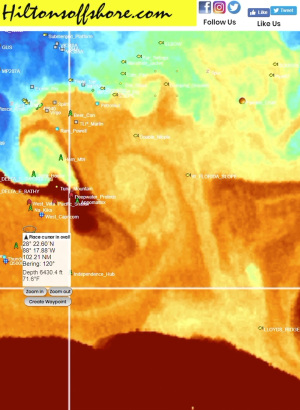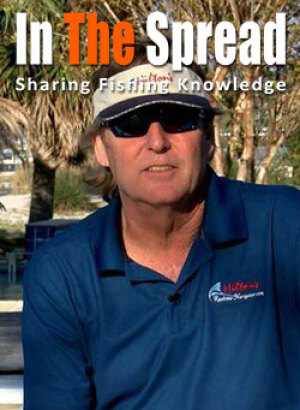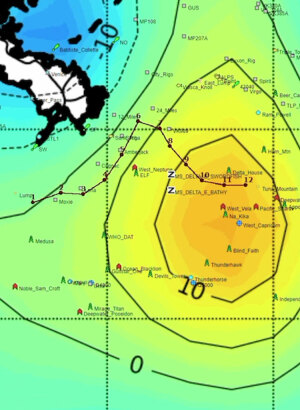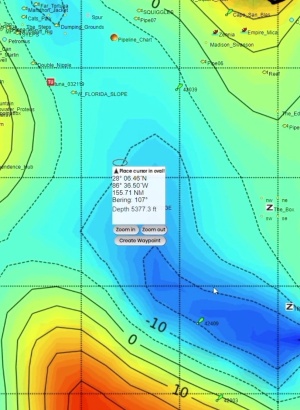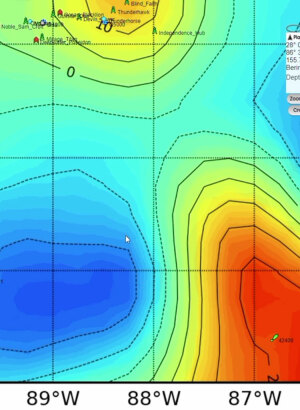Altimetry data can enhance fishermen's fishing activities by providing information on sea surface height, which can be used to predict oceanographic conditions that directly affect the distribution and abundance of marine life.
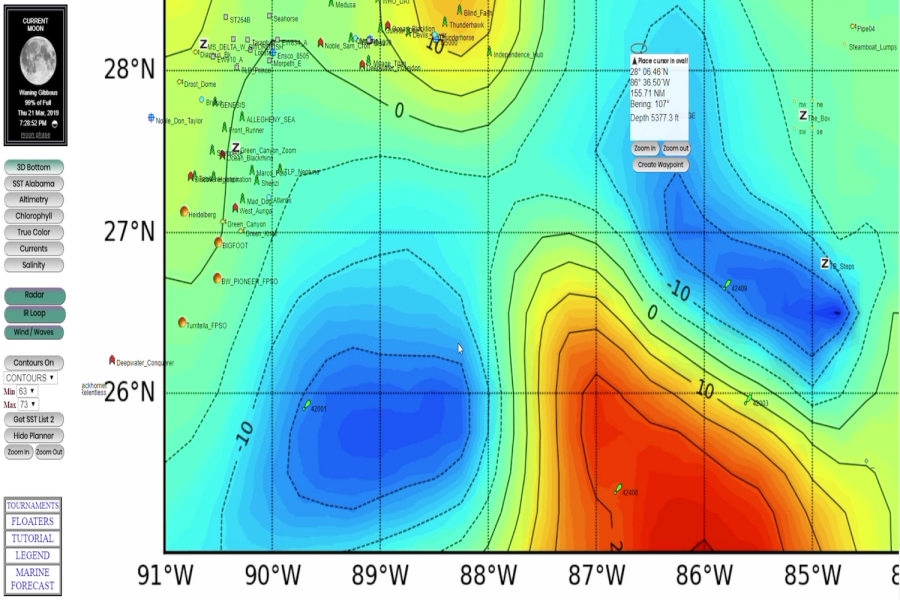
Altimetry - How to Improve Offshore Fishing
Altimetry is the measurement of altitude or elevation above a reference point, typically the Earth's surface. In the context of oceanography, altimetry refers to the measurement of sea surface height relative to a reference level, such as the Earth's geoid (an equipotential surface representing the Earth's mean sea level). Ocean altimetry is crucial for understanding various oceanographic phenomena and has numerous applications in climate research, marine navigation, and coastal management.
If you want to skip right to a video with Tom Hilton explaining how to use altimetry data to locate upwellings or dynamic fishing grounds, be sure to watch How Altimetry Charts Work.
Ocean altimetry is usually accomplished using satellite-based remote sensing techniques. Satellite altimeters, such as those onboard the Jason series or the European Space Agency's (ESA) Sentinel-6, emit radar pulses towards the Earth's surface. These pulses reflect off the ocean surface and return to the satellite. By measuring the time it takes for the radar pulse to travel to the ocean surface and back, scientists can calculate the distance between the satellite and the sea surface. Combined with precise satellite positioning data, this information is used to determine sea surface height.
Ocean altimetry data helps scientists understand and monitor various oceanographic processes, such as:
- Sea level rise: By measuring changes in sea surface height over time, researchers can track the global and regional impacts of climate change on sea level. This information is vital for predicting and mitigating the effects of sea level rise on coastal communities and ecosystems.
- Ocean currents: The difference in sea surface height across an area can be used to derive information about ocean currents, as water tends to flow from areas of higher elevation to lower elevation. Understanding ocean currents is essential for climate research, as they play a crucial role in transporting heat and regulating global temperatures.
- Tides and storm surges: Altimetry data can be used to monitor and predict tidal variations and storm surges, which can have significant impacts on coastal areas.
- Ocean eddies: Sea surface height variations can also reveal the presence of ocean eddies, which are circular currents that transport heat, nutrients, and other properties throughout the ocean. These eddies play a crucial role in ocean circulation and are essential to understanding the dynamics of marine ecosystems.
- Geostrophic balance: Altimetry data can be used to study the geostrophic balance, a state of equilibrium where the pressure gradient force and Coriolis force acting on a parcel of water are equal and opposite. This balance is essential for understanding the dynamics of large-scale ocean circulation.
Overall, ocean altimetry provides valuable insights into the complex dynamics of the Earth's oceans, helping scientists better understand and predict the impacts of climate change, as well as informing maritime activities and coastal management strategies.
HOW TO USE ALTIMETRY DATA FOR BETTER FISHING
Fishermen can use altimetry data to improve their fishing activities in several ways. Ocean altimetry provides information on sea surface height, which can be used to infer various oceanographic conditions that directly influence the distribution and abundance of marine life. Here are some ways fishermen can use altimetry data for better fishing:
- Identifying ocean fronts and eddies: Altimetry data can reveal the presence of ocean fronts, where two water masses with different temperatures and salinities meet, as well as ocean eddies, which are circular currents that trap and transport water. These areas often have high concentrations of nutrients and plankton, leading to increased productivity and an abundance of fish. By targeting these areas, fishermen can potentially increase their catch.
- Locating upwelling and downwelling zones: Altimetry data can help identify areas where upwelling or downwelling occurs. Upwelling occurs when deep, nutrient-rich water rises to the surface, leading to increased primary productivity and attracting fish populations. Downwelling, on the other hand, occurs when surface waters sink, often leading to lower productivity and fewer fish. By targeting upwelling zones, fishermen can improve their chances of catching fish.
- Tracking ocean currents: Altimetry data can be used to derive information about ocean currents, which can influence the distribution and movement of fish populations. Fishermen can use this information to identify areas where fish are more likely to be found, such as convergence zones or along the edges of strong currents.
- Monitoring sea level anomalies: Fishermen can use altimetry data to track sea level anomalies, which are variations in sea surface height that deviate from the mean level. These anomalies can be associated with oceanographic features like mesoscale eddies, which can influence the distribution of fish and other marine life.
- Long-term planning and sustainability: By using historical altimetry data, fishermen can study the long-term trends and variations in oceanographic conditions. This information can help them make informed decisions about where and when to fish, as well as contribute to the development of sustainable fishing practices that consider the impact of changing ocean conditions on fish populations.
It is important to note that while altimetry data can provide valuable information for fishermen, it is most effective when combined with other sources of oceanographic data, such as sea surface temperature, chlorophyll concentration, and salinity. Combining these datasets can help fishermen gain a more comprehensive understanding of the ocean environment and make more informed decisions about their fishing activities.
Why Areas of Upwelling Make for Better Fishing
Upwelling is an oceanographic process in which deep, cold, and nutrient-rich water rises to the surface, replacing warmer and nutrient-depleted surface water. This process occurs due to various factors, including wind-driven circulation, the deflection of ocean currents by the Earth's rotation (Coriolis effect), and the interaction of currents with coastal and ocean floor topography.
Areas of upwelling are particularly important for marine ecosystems and fishing because of the following reasons:
- Nutrient enrichment: The deep water brought to the surface during upwelling is rich in nutrients like nitrate, phosphate, and silicate. These nutrients are essential for the growth of phytoplankton, the microscopic plants that form the base of the marine food web. In nutrient-depleted surface waters, phytoplankton growth can be limited, reducing overall productivity.
- Enhanced primary productivity: As upwelling brings nutrient-rich water to the surface, it fuels the growth of phytoplankton. This increased primary productivity results in a more abundant food source for zooplankton, which are small marine animals that feed on phytoplankton. This, in turn, benefits higher trophic levels, such as fish, seabirds, and marine mammals.
- Increased fish biomass and diversity: The abundance of food resulting from upwelling-driven primary productivity attracts a wide variety of fish species, leading to increased fish biomass and diversity. Fish are drawn to these areas to feed on the abundant zooplankton and smaller fish, making upwelling zones hotspots for fishing activities.
- Spawning and nursery grounds: Some fish species take advantage of the increased food availability and favorable conditions in upwelling areas to spawn and rear their young. These areas can act as important nursery grounds for juvenile fish, contributing to the overall productivity and sustainability of fish populations.
- Predictable fishing grounds: Upwelling zones are often predictable in space and time, as they are typically associated with specific coastal features (e.g., headlands, submarine canyons) or occur seasonally due to wind patterns. This predictability allows fishermen to target these areas more effectively, increasing their chances of success.
This is a key point; upwelling areas create nutrient-rich, highly productive environments that support a diverse and abundant marine life, including numerous fish species. These conditions make upwelling zones ideal fishing grounds, as they provide a reliable source of food for fish and, consequently, higher catch potential for fishermen.
Why Fishermen Should Avoid Areas of Downwelling
Downwelling is an oceanographic process in which surface water sinks and is replaced by deeper water, driven by factors such as wind circulation, the Earth's rotation (Coriolis effect), and the interaction of ocean currents with coastal and ocean floor topography. In contrast to upwelling, which brings nutrient-rich water to the surface, downwelling transports surface water, which is typically warmer and nutrient-depleted, to greater depths.
Downwelling zones generally result in lower biological productivity and can be less favorable for fishing due to the following reasons:
- Nutrient depletion: As downwelling forces nutrient-poor surface water into deeper layers, the availability of essential nutrients such as nitrate, phosphate, and silicate decreases. This reduction in nutrient availability can limit the growth of phytoplankton, the microscopic plants that form the base of the marine food web.
- Reduced primary productivity: With lower nutrient concentrations, phytoplankton growth is limited, resulting in reduced primary productivity. This, in turn, impacts the availability of food for higher trophic levels, including zooplankton, fish, and other marine organisms, leading to decreased overall productivity in downwelling zones.
- Lower fish biomass and diversity: Due to the reduced primary productivity and limited food availability in downwelling areas, fish biomass and diversity are generally lower compared to upwelling zones. Fish may be less abundant and more dispersed in these areas, making them less attractive fishing grounds.
- Less favorable spawning and nursery conditions: Downwelling zones may provide less favorable conditions for fish spawning and nursery grounds due to the reduced food availability and lower overall productivity. As a result, these areas may not support the same level of fish population growth and sustainability as upwelling zones.
- Less predictable fishing grounds: Downwelling zones may be less predictable in space and time compared to upwelling areas, making it more challenging for fishermen to target these regions effectively. This unpredictability, combined with the lower productivity, can result in reduced fishing success in downwelling areas.
This is super important. Downwelling areas are characterized by nutrient depletion and reduced primary productivity, leading to lower fish biomass and diversity. These conditions make downwelling zones less favorable for fishing, as they offer fewer opportunities for successful catches compared to more productive upwelling regions.
Correlating Altimetry, Sea Surface Temperature and Chlorophyll Concentrations
Correlating altimetry, sea surface temperature (SST), and chlorophyll concentration is crucial for understanding and predicting the distribution and abundance of fish in offshore fishing areas. These three variables provide complementary information about the oceanographic conditions that influence marine life. Here are some best practices for integrating these data sources when it comes to offshore fishing:
- Data acquisition: Obtain the most recent and accurate satellite data for altimetry, SST, and chlorophyll concentration. Several organizations and platforms provide this data, such as NASA's OceanColor Web, NOAA's CoastWatch, or Copernicus Marine Service. Make sure to use data with appropriate spatial and temporal resolutions that match your fishing area and time scale of interest.
- Data visualization: Use Geographic Information System (GIS) software or online mapping tools to visualize the data layers for altimetry, SST, and chlorophyll concentration. Overlaying these datasets can help identify areas where favorable conditions for fish aggregation occur. Color-coding or contouring the data can make it easier to identify patterns and trends.
- Identifying oceanographic features: Analyze the combined data to identify oceanographic features that are likely to be associated with increased fish abundance. For example: Altimetry data: Look for areas with sea surface height anomalies, which may indicate the presence of oceanic eddies or fronts. SST data: Identify thermal gradients, where warm and cold water masses meet, or areas with specific temperature preferences for your target fish species. Chlorophyll concentration data: Locate areas with high chlorophyll levels, indicating increased primary productivity and potential fish aggregation.
- Correlation analysis: Perform correlation analysis between the altimetry, SST, and chlorophyll concentration data to understand the relationships between these variables and fish distribution. This can help in identifying specific conditions that are favorable for the target fish species and guide fishing efforts more effectively.
- Historical data analysis: Analyze historical data for altimetry, SST, and chlorophyll concentration to understand the long-term trends and variability in the study area. This can provide valuable insights into how oceanographic conditions have changed over time and their potential impact on fish distribution and abundance.
- Real-time monitoring: Keep track of real-time data updates for altimetry, SST, and chlorophyll concentration. This can help fishermen adapt their fishing strategies based on the latest oceanographic conditions.
- Collaboration with experts: Work closely with oceanographers, fisheries biologists, and other experts to better understand the relationships between altimetry, SST, and chlorophyll concentration data and their implications for offshore fishing. This collaborative approach can lead to improved decision-making and more successful fishing efforts.
By following these best practices, fishermen can integrate altimetry, SST, and chlorophyll concentration data to identify areas with favorable oceanographic conditions for their target fish species. This approach can improve fishing efficiency and support sustainable fishing practices by focusing on areas with higher catch potential while minimizing impacts on the marine ecosystem.
Structure is the Key
Relating the correlation of altimetry, sea surface temperature (SST), and chlorophyll concentration data to underwater structures can further enhance the effectiveness of offshore fishing efforts. Underwater structures, such as seamounts, reefs, shipwrecks, or artificial reefs, can have a significant impact on the distribution and behavior of fish. Here are some benefits of considering the relationship between oceanographic data and underwater structures for offshore fishermen:
- Enhanced fish aggregation: Fish are often attracted to underwater structures, as they provide shelter, food, and favorable spawning habitats. Combining the information from altimetry, SST, and chlorophyll concentration data with knowledge of the underwater structure can help identify areas with increased fish abundance, improving fishing efficiency and success.
- Better understanding of fish behavior: Studying the interaction between oceanographic conditions and underwater structures can provide insights into fish behavior, such as migration patterns, feeding habits, and preferred habitats. This understanding can help fishermen target specific fish species more effectively and develop fishing strategies tailored to the observed behavior.
- Improved sustainability: By focusing on areas where fish are more likely to aggregate, fishermen can minimize the impact of fishing on the marine ecosystem, reducing the likelihood of overfishing and promoting sustainable fishing practices. This approach helps conserve fish populations and maintain healthy ecosystems, ensuring the long-term viability of fishing industries.
- Greater fishing predictability: Incorporating underwater structure information with oceanographic data can help fishermen identify patterns and trends in fish distribution and behavior, making it easier to predict where fish are likely to be found. This predictability can lead to more successful fishing trips and reduced time spent searching for fish.
- Reduced fishing effort: By targeting areas with favorable oceanographic conditions and underwater structures, fishermen can reduce the time and effort spent searching for fish, resulting in lower fuel consumption and operating costs. This can lead to more cost-effective and environmentally friendly fishing operations.
- Enhanced collaboration and data sharing: Combining oceanographic data with underwater structure information encourages collaboration between fishermen, oceanographers, fisheries biologists, and other experts. This collaboration can lead to better data sharing, improved decision-making, and more successful fishing efforts.
In summary, relating the correlation of altimetry, SST, and chlorophyll concentration data to underwater structures provides offshore fishermen with a more comprehensive understanding of fish distribution and behavior. This approach can improve fishing efficiency and success, promote sustainable fishing practices, and reduce the environmental impact of fishing operations.
Watch this valuable video Fishing Forecast - Hiltons Realtime Navigator to learn more about how to read, analyze and correlate multiple date sets to zero in on the most productive fishing area. This will save you time and money, plus put you in fish faster.
Satellite Data Services
There are several satellite data services that provide valuable information to fishermen, including data on sea surface temperature, chlorophyll concentration, ocean altimetry, and ocean currents. Some of the best satellite data services used by fishermen are:
- NOAA CoastWatch: NOAA's CoastWatch program offers a wide range of satellite-derived data products, including sea surface temperature, ocean color (which provides chlorophyll concentration), ocean surface winds, and ocean altimetry. These products can be accessed through their OceanWatch Data Portal and are frequently used by fishermen to monitor and predict oceanographic conditions. URL: https://coastwatch.noaa.gov/
- NASA OceanColor Web: The NASA OceanColor Web provides access to satellite data products related to ocean color, which includes chlorophyll concentration, an essential indicator of primary productivity in the ocean. Fishermen can use this information to locate areas with high productivity and potential fish aggregation. URL: https://oceancolor.gsfc.nasa.gov/
- Copernicus Marine Service: The Copernicus Marine Service, part of the European Union's Earth Observation Program, offers a variety of satellite data products related to oceanography, including sea surface temperature, chlorophyll concentration, sea level anomaly, and ocean currents. These datasets can be accessed through their online portal and are useful for fishermen to make informed decisions on their fishing activities. URL: https://marine.copernicus.eu/
- Remote Sensing Systems (RSS): RSS provides satellite-derived data products, including sea surface temperature, ocean surface winds, and sea surface height. These datasets can help fishermen understand oceanographic conditions and target areas with favorable conditions for their target fish species. URL: https://www.remss.com/
- CLS (Collecte Localisation Satellites): CLS offers satellite-derived data products and services related to oceanography, including sea surface temperature, ocean altimetry, and ocean currents. Fishermen can use these datasets to identify oceanographic features that may influence fish distribution and abundance. URL: https://www.cls.fr/
- Regional Ocean Data Assimilation Systems: Various regional ocean data assimilation systems, such as the Real-Time Ocean Forecast System (RTOFS) by NOAA or the European Copernicus Marine Environment Monitoring Service (CMEMS), provide high-resolution oceanographic data, including sea surface temperature, ocean currents, and sea surface height. These regional systems can help fishermen focus on specific areas and better understand local oceanographic conditions.
These satellite data services, among others, provide valuable information to fishermen, allowing them to make informed decisions and improve their fishing operations. By using these services and integrating the data with their knowledge of fish behavior and underwater structures, fishermen can enhance their fishing efficiency and promote sustainable fishing practices.
Subscription Services for Fishermen
Hilton's Realtime Navigator, ROFFS, and other private companies offer tailored oceanographic data services to fishermen, providing valuable information and expert analysis for optimizing fishing strategies. These companies integrate satellite-derived data products with their in-house expertise, delivering comprehensive and user-friendly information to support efficient and successful fishing operations.
- SatFish: SatFish is a subscription-based online service that provides high-definition satellite imagery and advanced mapping tools specifically designed for offshore fishing. It combines multiple data layers like sea surface temperature (SST), chlorophyll concentration, bathymetry, currents, and weather forecasts into detailed offshore fishing charts https://app.satfish.com/register?gad_source=1
- Hilton's Realtime Navigator: Hilton's Realtime Navigator is a subscription-based service that provides real-time oceanographic data, including sea surface temperature, ocean color (chlorophyll concentration), altimetry, and ocean currents, specifically tailored for fishermen. They offer easy-to-use, high-resolution maps and expert analysis to help fishermen locate areas with the highest potential for their target fish species. URL: https://www.realtime-navigator.com/
- ROFFS (Roffer's Ocean Fishing Forecasting Service): ROFFS is a fee-based service that offers customized fishing forecasts using a combination of satellite-derived data, such as sea surface temperature, chlorophyll concentration, and ocean currents, along with their in-house expertise in oceanography and fisheries science. They provide detailed fishing forecast reports, helping fishermen target productive fishing grounds more efficiently. URL: https://www.roffs.com/
These private companies often differentiate themselves from publicly available satellite data services by providing:
- Customized analysis: These companies offer tailored oceanographic analysis and interpretation for specific fishing areas, target species, and timeframes, making the information more relevant and actionable for fishermen.
- User-friendly presentation: They provide easy-to-read, high-resolution maps and charts, simplifying complex oceanographic data and making it more accessible for fishermen with varying levels of technical expertise.
- Expert support: Many private companies have in-house experts in oceanography and fisheries science, who can offer guidance and insights based on their experience and understanding of local conditions and fish behavior.
- Real-time data and updates: These companies often focus on providing real-time or near-real-time data, enabling fishermen to make decisions based on the latest oceanographic conditions.
While subscription or fee-based services like SatFish, Hilton's Realtime Navigator and ROFFS come at a cost, many fishermen find the customized analysis, user-friendly presentation, and expert support worth the investment, as it can lead to more efficient and successful fishing operations and contribute to sustainable fishing practices. Seth Horne In The Spread, Chief Creator

